
Ever seen a building fly? That’s basically what the Boeing 747-8I is! This enormous airplane isn’t just big—it’s also the fastest Boeing jet zooming around our skies today.
The 747-8I is like that friend who’s both the tallest person at the party AND the fastest runner in town—nobody quite expects both traits in the same package. With its distinctive hump on top and 4 powerful engines, it carries over 400 people while still moving fast enough to make your hair blow back (if you could stick your head out the window—which we don’t recommend :P).
Pilots love flying this giant so much that they compare it to driving a luxury car instead of an actual airplane. Imagine piloting something bigger than your house that handles “even better than a tiny Cessna”, according to the experts. That’s like saying your monster truck has the ability of a sports car!
So, next time you look up and see a massive 747-8I cruising overhead, remember: that’s not just any plane—that’s the speediest big Boeing in the business, making other jets look like they’re moving in slow motion. Building on the legendary 747 family heritage, this aircraft delivers unmatched advantages for airlines operating long-haul routes, as flagged by Simple Flying.
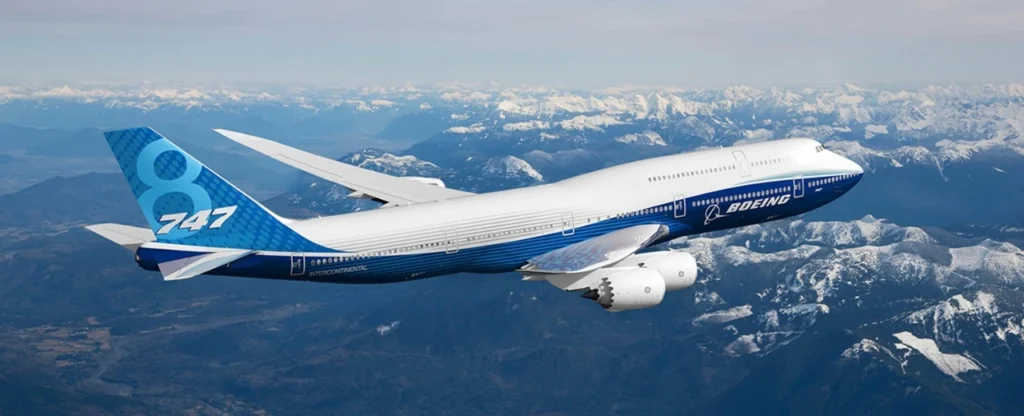 Boeing 747-8I; Photo- Boeing
Boeing 747-8I; Photo- BoeingBoeing 747-8I Technicalities
Speed
The “dash eight” variant earns its place as the crown jewel of the 747 legacy through a perfect blend of enormous size, extended range, impressive cruising speed, and strong fuel efficiency. Boeing designated the passenger version as the 747-8I “Intercontinental,” while the cargo model carries the 747-8F “Freighter” designation—both leading their classes in numerous technical aspects, particularly airspeed.
This aircraft typically cruises at approximately Mach 0.85–0.86, translating to about 570 mph (915 km/h) at cruising altitude. While other airliners can reach similar speeds, none match the complete package offered by the 747-8I.
 Photo- Wikimedia Commons; Compiled by Aviation A2Z
Photo- Wikimedia Commons; Compiled by Aviation A2ZEngineering
Boeing developed the 747-8I as a successor to the 747-400, introducing significant improvements, including an expanded fuselage, redesigned wing structure, and modified upper deck cabin layout. The aircraft features modernized avionics and technology, but the new engines represent the most crucial advancement, delivering both increased speed and enhanced efficiency.
The 747-8I, Boeing’s largest passenger aircraft to date, was designed to fill the market gap between the Airbus A380 superjumbo and twin-engine widebodies like the 777-300ER. Its maiden flight occurred in 2011.
“The 747-8 Intercontinental and 747-8 Freighter incorporate the GEnx engine—one of the cleanest, quietest, and most fuel-efficient turbofan engines in the world. It is based on the 787 Dreamliner engine, but optimized for the 747-8.”
Boeing’s design highlights
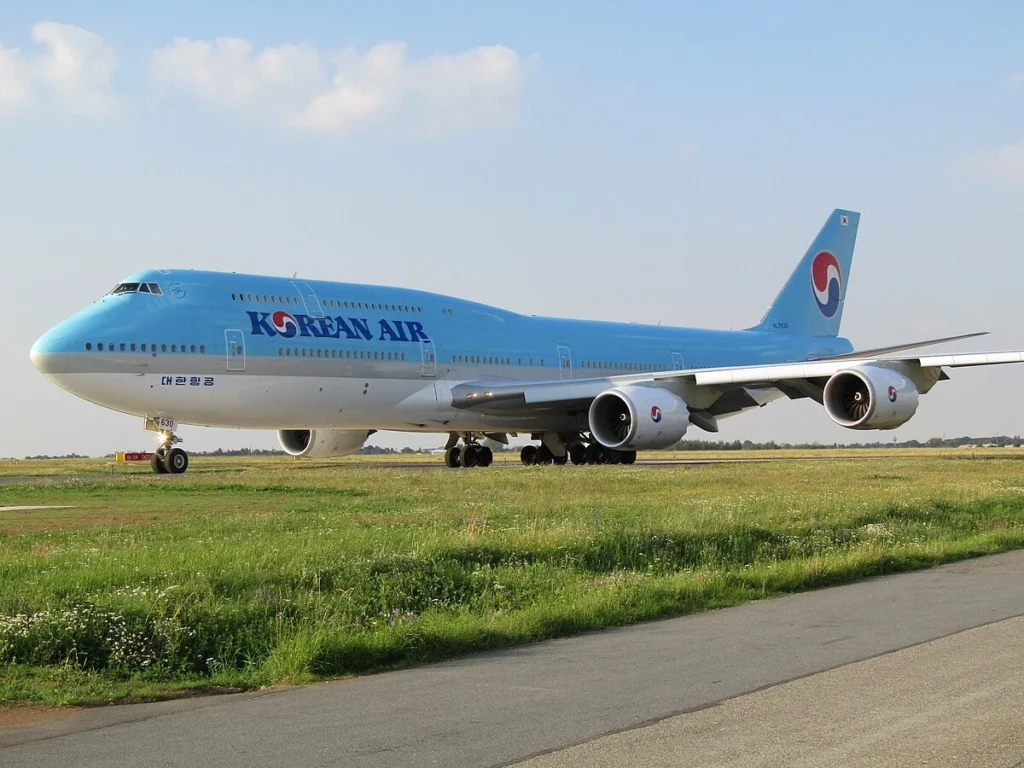 Photo- Lukáš Musil; Wikimedia Commons
Photo- Lukáš Musil; Wikimedia CommonsTechnical Advancements
The GEnx engines represented cutting-edge technology when Lufthansa (LH) introduced the “dash eight” to commercial service in 2012. These advanced powerplants not only improved the fuel economy of this massive JumboJet but also significantly reduced noise levels compared to its predecessor.
“Dual chevrons and a sound-absorbing liner on the nacelle diminish noise during takeoff, and simplified flaps on the wing trailing edge reduce noise during landings. The 747-8 is 15 decibels quieter than the Stage 4/Chapter 4 noise limit that ICAO established for aircraft certified after 2006.”
Boeing
The 747-8I features thoroughly redesigned wings compared to earlier models. Rather than the 747-400’s winglets, the newer aircraft sports deeper, thicker wings with contemporary aerodynamics and raked wingtips. These long, sweeping wingtips enhance fuel economy and reduce drag at high speeds. The engine nacelles include scalloped trailing edges, first developed for the 787, which smooth airflow to minimize noise.
Boeing utilized modern materials and design techniques in constructing the aircraft to reduce weight. Each engine delivers approximately 66,500 pounds of thrust, providing the 747-8I with sufficient power to carry heavier loads while maintaining faster cruise speeds at altitude.
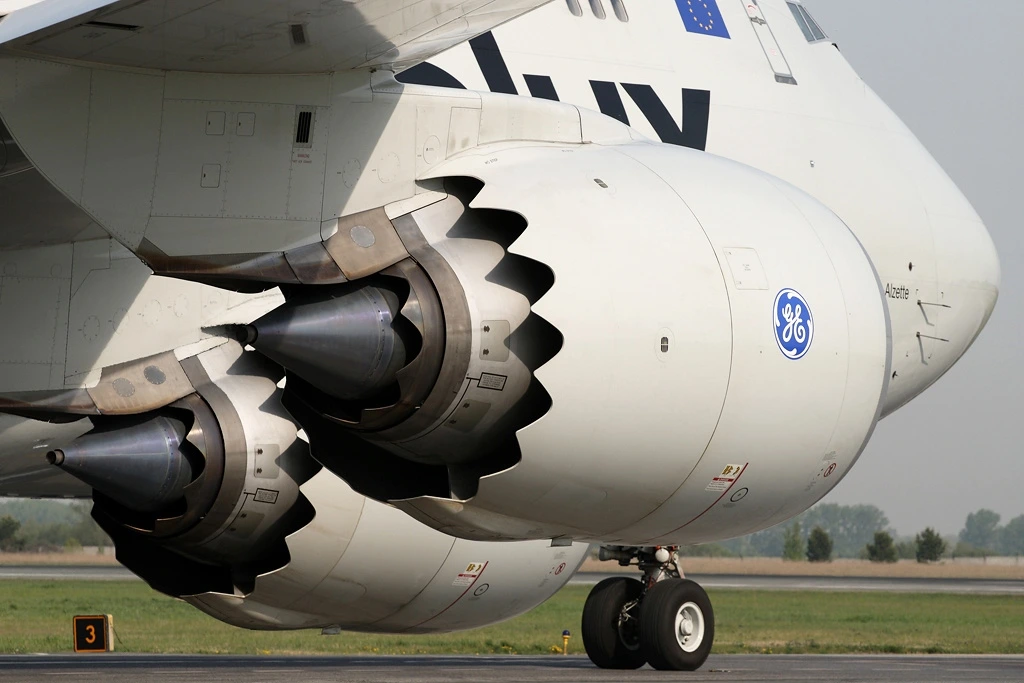 Photo- Gleb Osokin – Russian AviaPhoto Team; Wikimedia Commons
Photo- Gleb Osokin – Russian AviaPhoto Team; Wikimedia CommonsOperational Excellence
The Boeing 747-8I can travel up to 8,000 nautical miles without refueling, enabling non-stop flights between major global cities. Its spacious two-deck interior accommodates approximately 400-500 passengers, depending on airline configuration.
The “Dash Eight” achieves maximum fuel efficiency for its capacity, with its advanced engines and improved aerodynamics resulting in 15% lower fuel consumption and CO₂ emissions per seat compared to the 747-400.
These efficiencies help offset the operating costs associated with its four engines. Pilots transitioning from earlier 747 models benefit from nearly identical cockpit layouts and handling characteristics. Overall, the 747-8I delivers an optimal combination of speed, range, and capacity, allowing carriers like Lufthansa (LH) and Korean Air (KE) to efficiently serve high-demand, long-haul routes.
Lufthansa (LH) operates the 747-8I on routes such as Frankfurt (FRA) to Los Angeles Airport and Frankfurt (FRA) to Delhi (DEL), where its speed and range help maintain tight schedules on ultra-long flights. The jet’s fast cruise speed results in slightly shorter journey times and convenient scheduling, serving as a subtle selling point for both airlines and passengers on premium long-haul services.
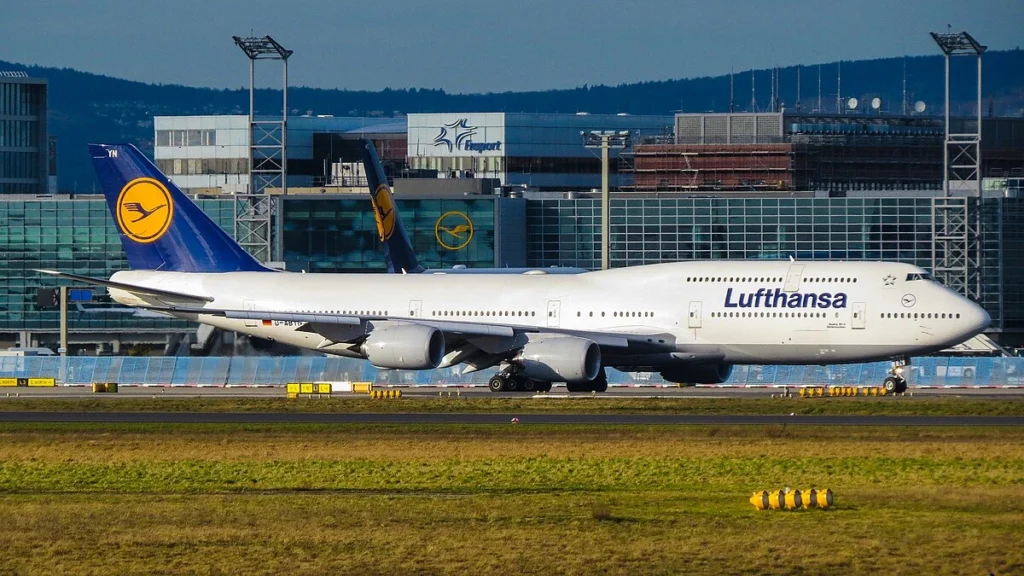 Photo- Kiefer. from Frankfurt, Germany; Wikimedia Commons
Photo- Kiefer. from Frankfurt, Germany; Wikimedia CommonsLegacy of Excellence
The 747 has always held a special place in aviation history, earning more admiration than virtually any other passenger aircraft. Even the larger, newer double-decker Airbus A380 has never captured the same charm and appeal that surrounds the 747.
“I went on in 1987 and was struck by the sheer size of it. The pilots sat four floors up. It was a real pilot’s aeroplane. It was probably the last aeroplane that was flown by a pilot and not a computer. It was a huge aeroplane but it flew so beautifully even in bad weather. It was like an ocean liner in the sky. I’ve flown lots of different types of aeroplanes, but when I started flying the jumbo, I just had a big silly grin across my face.”
Nick Eades, World’s Most Experienced 747 Pilot (with 34 years flying jumbos for British Airways (BA) and 27,000 logged hours)
The 747 remains popular among pilots, partly for the prestige of operating one of the world’s largest aircraft, but more significantly for its exceptional handling characteristics. This giant Boeing jet has earned a reputation for providing an enjoyable flying experience for flight crews.
“I tested high speed and low speed in the 747-8 and demonstrated full aerodynamic stalls. It stalls at full aft stick even better than a Cessna 172. It’s an amazingly light and flexible airplane for its size, so we designed the fly-by-wire ailerons [in the 747-8] to automatically help dampen out any vibrations and smooth out the ride.”
Kirk Vining, Former Engineering Project Pilot on the 747-8 Freighter and Intercontinental
The aircraft’s appeal extends beyond pilots. Despite Boeing ending production, Atlas Air (5Y) continues acquiring more of these giant jets for their cargo fleet. As recently as 2024, the carrier finalized a deal to add 3 more 747-8Fs to their inventory.
 Photo- Alex Beltyukov; Wikimedia Commons
Photo- Alex Beltyukov; Wikimedia CommonsTechnical Specifications and Future
The United States Air Force selected the 747-8I platform (designated VC-25B) for the next-generation Air Force One presidential aircraft, highlighting its unique combination of range, speed, and space. The program has faced significant delays and recent scrutiny from Donald Trump and Elon Musk. Boeing reports substantial financial losses due to program overruns, but with recent adjustments, hopes remain high for getting the latest Air Force One iteration back on schedule.
The first two 747-8Is destined for Air Force One duty continue undergoing conversion and testing, with the Air Force confirming the model’s cruise speed of Mach 0.855, making it the world’s fastest commercial jet. Flying aboard one of these giants offers the closest experience to traveling at the speed of sound on a passenger jet.
While the production line has closed, the special USAF program ensures that the VC-25Bs will be the last two 747s manufactured (at least for now), adding two more majestic giants to the skies. Key specifications for Boeing’s impressive 747-8I include:
- Passenger Capacity (typical three-class): 410 seats
- Range: 7,730 nautical miles (14,310 km)
- Length: 250 feet 2 inches (76.3 m)
- Wingspan: 224 feet 5 inches (68.4 m)
- Height: 63 feet 6 inches (19.4 m)
- Cruise Speed: Mach 0.86 (around 570 mph or 917 km/h)
- Top Speed: 706 mph (917 km/h)
- Maximum Takeoff Weight: 987,000 lb (447,696 kg)
- Engines: GE Aerospace GEnx-2B, each producing 66,500 lb (295.7 kN) of thrust
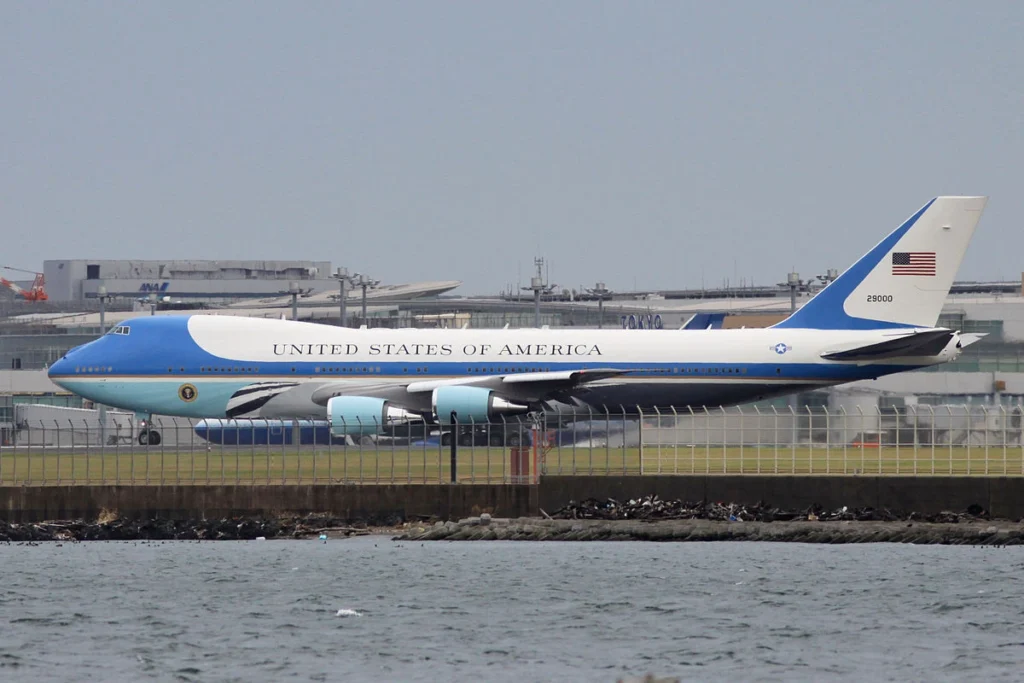 Photo- Kentaro Iemoto from Tokyo, Japan; Wikimedia Commons
Photo- Kentaro Iemoto from Tokyo, Japan; Wikimedia CommonsBottom Line
The Boeing 747-8I stands tall as not just the fastest Boeing jet in service but as the final chapter in the remarkable story of the iconic “Queen of the Skies” family. While production has now ended after more than 50 years of 747s gracing our skies (they’ve had a longer run than most Hollywood marriages), the legacy continues through cargo operations and the future Air Force One aircraft currently under development.
The “dash eight” represents the pinnacle of Boeing’s jumbo jet evolution, with its advanced GEnx engines, redesigned wings, and technological improvements making it not just faster but also more efficient and quieter than its predecessors – like your grandpa’s old station wagon suddenly transformed into a Tesla that can whisper. It is loved by pilots for its surprisingly nimble handling (imagine an elephant that does ballet) and by airlines for its economics.
The 747-8I reminds us that sometimes the biggest things can also be the most impressive performers, proving that “go big AND go home quickly” is possible in aviation!
Stay tuned with us. Further, follow us on social media for the latest updates.
Join us on Telegram Group for the Latest Aviation Updates. Subsequently, follow us on Google News
Atlas Air Boeing 747 Cargo Plane | Where do they Fly them?
The post Fastest Boeing Plane and its Not 777 or 787 appeared first on Aviation A2Z.

 5 miesięcy temu
5 miesięcy temu











